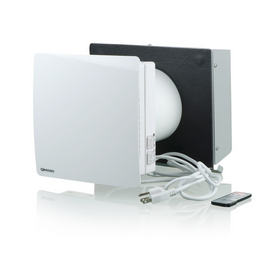- Home

Recycled Drywall
Drywall is by far the most common type of interior wall used in homes in the United States. Over 15 million tons of new drywall is produced each year by construction manufacturers. When building a new home, almost 12% of the drywall is wasted during the installation process without ever having been used.
Drywall (also known as gypsum board, wallboard, plasterboard, and sheetrock) is made from calcium sulfate dehydrate, a mineral found in ancient sea beds that have since dried up. Because it is a natural material, it can also be easily recycled.
When drywall is disposed of in landfills, it leads to anaerobic decomposition situations where harmful gasses such as hydrogen sulfide are released into the surrounding area. To avoid these problems associated with landfill disposal, the gypsum in drywall can be recycled into new pieces of drywall that maintain that exact same standards and performance while reducing the need to continue to mine new sources of gypsum from around the world.
Recycled drywall costs the same (or even less) than new drywall, and you can find a list of recycled drywall providers here.

Dual Flush Toilets
Older toilets can use up to 7 gallons of water per flush, thus constituting a major source of water expenditure in the home. If you have been considering purchasing a new toilet for your bathroom, dual flush toilets can save you enormous amounts of water. Besides limiting the amount of water per flush, these fixtures also allow you to choose between two flush options: a lower volume flush for liquid waste and a higher volume flush for solid waste. The best part of dual flush toilets is that they don’t cost any more than other types of toilets on the market. One consumer website reports that the average cost of toilets today ranges between $200 and $400, while dual flush toilets can be found for as low as $150.

LEDs
While the $0.75 you pay for a 40-watt incandescent light bulb is going to be the cheapest individual bulb on the market no matter where you shop, LED light bulbs are continuing to drop in cost, and you can often find 7 to 10 watt LEDs for under $2 each. The extra dollar you paid for LED bulbs will quickly be paid back. While running a 12-watt LED will only cost you around $1 per year, the same cost for a 60-watt incandescent would be around $5.

Zero VOC Paint
Changing the color of a bedroom or your kitchen is a household maintenance activity most homeowners do at least once a year. Unfortunately, many commercial paints on the market today contain high levels of VOCs that lower indoor air quality and lead to respiratory problems and other serious health issues.
No VOC paint costs anywhere between $20 and $70 per gallon, similar to the wide range of regular paints on the market today. Choosing to repaint your bedroom with no VOC paint is a simple and affordable strategy to improve the indoor air quality in your home.
Tobias Roberts
Tobias runs an agroecology farm and a natural building collective in the mountains of El Salvador. He specializes in earthen construction methods and uses permaculture design methods to integrate structures into the sustainability of the landscape.














